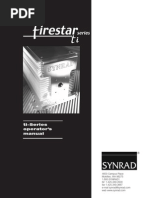Ansi Aami He75 2009 Edition Nfpa
ANSI/AAMI ES60601-1:2005/(R)2012 (IEC 60601-1:2005 MOD) Medical electrical equipment—Part 1. NFPA 70 517.18. NFPA 70E: Standard for Electrical Safety in the Workplace, 2015 edition, paragraph 120.1. NFPA 70E 120.1. NFPA 99: Health Care Facilities Code, 2012. C1:2009(R)2012, and A2:2010(R)2012.
54.jpg)

What laser class is this? Lasers cannot emit an average radiant power greater than 0.5 Watts for an exposure time equal to or greater than 0.25 seconds or 0.125 Joules for an exposure time less than 0.25 seconds for wavelengths between 0.18 µm and 0.4 µm, or between 1.4 µm and 1 mm. In addition, lasers between 0.4 µm and 1.4 µm exceeding the Class 3a AEL cannot emit an average radiant power greater than 0.5 Watts for exposures equal to or greater than 0.25 seconds, or a radiant energy greater than 0. George Harrison Greatest Hits Flac Torrent. 03 Joules per pulse.
If during routine preventive maintenance service of a medical device it is found that there is evidence of fluid being spilled onto the device, the appropriate action to take is (a) clean and test the device, and return it to service (b) discuss the source of the fluid with the clinical staff, and then discard the device (c) refuse to service the device because the spill is the clinical staff's responsibility (d) discuss the source of the fluid with the clinical staff, and then clean and test the device and return it to service (e) None of the above. There are a number of different activities where personnel of the clinical engineering department spend their time. If the department is required to account to hospital management for its time, which of the following would be most difficult to justify? Time spent in unplanned hallway conversation. Fallout New Vegas Ost Скачать here. Time spent in transit from one part of the hospital to another. Time spent attending manufacturer's training programs. Time spent at equipment selection committee meetings.
None of the above. When responding to a request for service on a medical device it is not uncommon for the technician to find that they cannot re-create the condition that the user complained about. When this occurs the technician should (a) Close out the work order as service completed with 'no problem verified'.
(b) Remove the device from service until the condition complained about can be duplicated. (c) Remove the device and all identical units of the device from service until the condition complained about can be duplicated (d) Interact with the user to try to better understand the user's observation, particularly if prior 'no problem verified' work orders occurred previously for this device. A service call comes in the middle of the night as follows: A physiological monitor is not working in an ICU and it is connected to a critical patient. The most appropriate response is: (a) We will take care of it the next morning (b) Attempt to troubleshoot and correct the problem in discussion over the phone (e.g. Cycle power,). See if there is a spare readily available or if patient can be moved if there is another vacant bed. If no to all of the above, follow callback protocol (e.g.
Dispatch someone (or yourself) to go in and solve the problem). (c) Tell them to find a portable monitor and use it until someone comes in the morning (d) Call the OEM help line. The industrial, scientific, and medical radio band (ISM band) refers to a group of radio bands or parts of the radio spectrum that are internationally reserved for the use of radio frequency (RF) energy intended for scientific, medical and industrial requirements rather than for communications. ISM bands are generally open frequency bands, which vary according to different regions and permits. ISM band is unlicensed - 802.11b,g is 2.42 GHz (same as microwave ovens). The NEW ISM tele is 802.11.a at 5GHz.
Comments are closed.